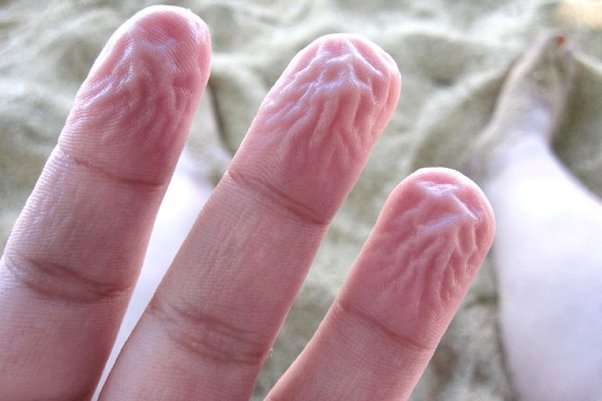If you spend more than a few minutes in water (like a bath or a swimming pool), your fingertips will change dramatically. Engorged folds of unsightly pruned skin will be found where there were formerly elegant whorls of the gently ridged epidermis.
This drastic shift is both recognizable and puzzling. Immersion in water causes just the skin on our fingers and toes to wrinkle; the skin on our forearms, torso, legs, and face shows no signs of wrinkling at all.


For decades, scientists have been trying to figure out why our fingertips and toes wrinkle when we get wet. Researchers have recently become interested in the why and possible function of this puckering, which has long baffled the general public. But what our shriveled fingers can tell us about our health is perhaps even more intriguing.
Water at 40 degrees Celsius (104 degrees Fahrenheit) is ideal for wrinkling your fingertips, but even water at 20 degrees Celsius (68 degrees Fahrenheit) can take up to 10 minutes. However, most research has indicated that bathing for about 30 minutes results in the most wrinkles.
Osmosis
Osmosis, in which water molecules travel across a membrane to equalize the concentration of liquids on either side, was long assumed to be a passive response responsible for the wrinkling of fingers. However, scientists have known there must be more to the process than this since at least 1935.
Researchers observed no signs of wrinkling in the fingers of patients whose median nerves, which go from the elbow to the hand, had been severed in accidents. The median nerve regulates the body’s sympathetic functions, such as perspiration and vasoconstriction. Their finding revealed the nervous system was responsible for the crinkling of fingertips when exposed to water.
This was further supported by research conducted in the 1970s by medical professionals, who advocated for performing a simple bedside test involving the immersion of the patient’s hands in water to evaluate nerve injury that might influence the regulation of unconscious processes like blood flow.
The blood flow in the palms of volunteers was measured as they were drenched in water by neurologists Einar Wilder-Smith and Adeline Chow in 2003 at the National University Hospital in Singapore. Blood flow was shown to significantly decrease in the fingers when the skin of the volunteers’ fingertips wrinkled.
Similar degrees of wrinkling was seen when a local anesthetic cream was administered to the fingertips of healthy volunteers, causing the blood vessels to momentarily contract.
A Neurologist Has Investigated The Phenomenon
Nick Davis, a neurologist, and psychologist at Manchester Metropolitan University, has investigated the phenomenon of wrinkling fingertip skin. “It makes sense when you look at your fingers when they go wrinkly,” he says. When the blood supply to an area is cut off, the surrounding tissue turns pale.
Wilder-Smith and colleagues hypothesized that dipping our hands opens our finger sweat ducts, letting water in and generating a salt imbalance. This salt shift fires finger nerve fibers, narrowing sweat gland blood channels. As the flesh thins, the skin above the fingertip wrinkles. The pattern of wrinkles is determined by the epidermis’ relationship to the dermis, the skin’s next layer.
The skin’s outer layers may expand, causing wrinkles. Our fingers would be enormous if osmosis alone generated wrinkles. Pablo Saez Vias, a biomechanical engineer at the Technical University of Catalonia who used computer modeling to examine the mechanism, found that wrinkling increases when the top layers of skin swell while the lower levels shrink.
To have “normal levels of wrinkles,” he argues, “you need both.” “Wrinkles are suppressed if you don’t have that neurological response, which happens in some people.”
But if the nerves are in charge of wrinkling, then our bodies are actively reacting to the presence of water. Davis concludes, “That means it’s happening for a reason.” To which I reply, “And that means it could be giving us an advantage.”
Wrinkle-Free Hands Exerted Less Effort
Recently, Davis began investigating what this benefit might be after one of his children asked him in the bath why their fingertips had become wrinkly. Davis conducted his study by gauging the grip strength of 500 museum visitors to London’s Science Museum in the year 2020. Those with dry, wrinkle-free hands exerted less effort and maintained a firmer hold on the object than those whose hands were wet. The grip strength also decreased between the two after they soaked their hands in water to make them wrinkled for a few minutes.
“The results were amazingly clear,” Davis says. Because of the creases, there was more resistance when the fingertips touched the object. What’s really neat is that our fingertips can tell when there’s a change in the surface friction, and we use that information to use less force when holding on to anything.
Davis’s volunteers only needed a light grasp because the object they were holding weighed less than a few cents. This variation in friction may become more significant, though, when working under more demanding conditions under damp conditions.
When he says, “If you don’t have to squeeze as hard to grip something, the muscles in your hands get less tired, and so you can do it for longer,” he’s referring to the fact that gripping something tightly causes fatigue in the hand muscles.
He confirmed prior findings that wrinkling our fingertips helps us handle damp materials. In 2013, neuroscientists at Newcastle University in the UK instructed volunteers to transport glass marbles of different sizes and fishing weights between containers. One scenario has dry or submerged objects. Non-wrinkled fingertips took 17% longer to transfer submerged objects. Wrinkled fingertips moved weights and marbles underwater 12% faster. Dry things could be transferred with wrinkled or smooth hands.
Creases on Our Fingers and Toes
The creases on our fingers and toes may function similarly to the treads on a car’s tires or a shoe’s sole when it rains, according to some researchers. Wrinkles on your fingertips create channels that drain moisture away from your point of contact.
This provides support for the hypothesis that humans have evolved wrinkly fingertips and toes in order to improve their grip on slippery surfaces.
Tom Smulders, an evolutionary neurologist at Newcastle University who led the 2013 study, speculates that the adaptation “has to do with either locomotion in very wet conditions or potentially with manipulating objects underwater” due to the adaptation’s improved grip underwater. It might have helped our ancestors immensely when it came to, say, walking on damp rocks or holding onto branches. On the other hand, it might have come in handy when we were hunting or fishing for things like shellfish.
Smulders speculates that if it were the latter, it would be unique to humans, but if it were the former, it would be seen in other primates. It has not been observed in our closest ape cousins, such as chimpanzees, but it has been observed in the fingers of Japanese macaque monkeys, which are known to bathe for lengthy periods in hot water. Smulders argues that just because no one has found similar evidence in nonhuman primates does not indicate the phenomenon does not occur. To which I reply, “We don’t know the answer to this question yet.”
Other Strange Mysteries
The appearance of this adaptation in our species may be dated by other fascinating indicators. Wrinkling of the fingers takes longer and is less apparent in saltwater than in freshwater. This is likely due to the fact that the salt imbalance that activates the nerve fibers is attenuated in salt water due to the smaller salt gradient between the skin and the surrounding environment. This may have been an adaptation that allowed our ancestors to thrive in inland lakes and rivers rather than on the coasts.
However, there are no concrete explanations, and some have hypothesized that it is only a random physiological reaction serving no adaptive purpose.
Other strange mysteries include the fact that women age more slowly than men do when it comes to the appearance of wrinkles. If having wrinkled fingertips doesn’t hinder our ability to hold onto dry objects, then why does our skin go back to normal within 10-20 minutes? Why wouldn’t our fingertips always be wrinkled if they help us hold on better when it’s wet but don’t hurt us when it’s dry?
The wrinkles’ effect on touch may be a contributing factor. Even though one study found no difference in the ability to discern between objects based on touch, the pruning of our skin alters how we feel them.
Because “picking something up with wrinkly fingers feels weird,” Davis explains, “some people have a real aversion to it.” Perhaps the equilibrium of the skin’s receptors has shifted, or perhaps there is a psychological component at play. It would be interesting to learn the reason. We may be able to accomplish other things less well with our creased fingers.
Conclusion
However, when we put our fingers and toes in the water, startling things might be learned about our health. People with psoriasis and vitiligo, for instance, take longer to develop wrinkles than the general population. Excessive wrinkling of the palms and fingers is a common symptom of cystic fibrosis, and it has been observed in both patients and carriers of the disease. Sometimes people with type 2 diabetes have significantly less skin wrinkling when their hands are submerged in water. People with heart failure also have less wrinkling, which may be related to problems with their cardiovascular system’s regulation.
Fingers that wrinkle less evenly than the other while being immersed for the same amount of time may be an early indicator of Parkinson’s disease since it suggests an imbalance in the sympathetic nervous system.
The reason why our digits began to wrinkle in water is still a mystery, but doctors have found other surprising uses for our pruney digits.




